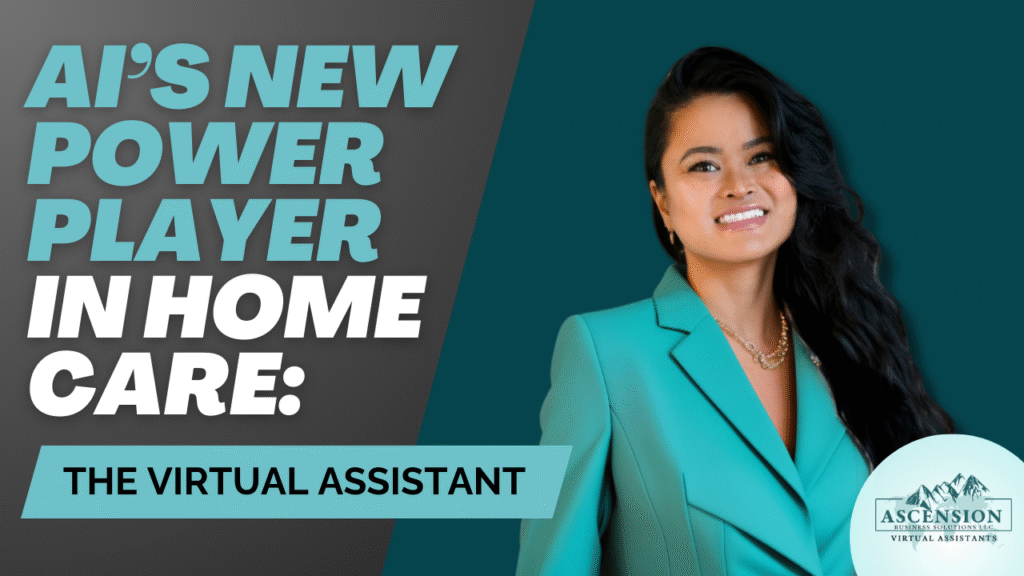Imagine this: your agency running smoother than ever, caregivers spending more time caring instead of wrestling with paperwork, and your ROI chart looking like it’s on rocket fuel.
Now imagine this transformation being driven not by another monitoring device or dashboard—but by a living, breathing, thinking colleague in the form of an AI-empowered Virtual Assistant.
That’s not science fiction anymore. That’s today. And for forward-thinking home care agencies, it’s the difference between keeping pace with the industry and dominating it.
The Current AI Landscape in Home Care: Helpful, But Limited
Walk into a modern home care agency today, and you’re likely to see some level of AI in play already:
Remote patient monitoring devices sending vitals to a central dashboard.
EHR (Electronic Health Records) systems with AI-powered data entry and analytics.
Wearable sensors tracking falls or medication adherence.
Predictive analytics tools identifying at-risk patients before an incident occurs.
These systems have undoubtedly improved efficiency. They help reduce hospital readmissions, track compliance, and create data-rich environments for better decision-making.
But here’s the catch:
Most of these tools are passive. They collect data, but they don’t act on it. They wait for a human to interpret the numbers and decide what to do next.
In other words, they’re valuable—but they’re not the kind of teammates that roll up their sleeves and get work done alongside you.
Enter the AI-Empowered Virtual Assistant: From Data Collector to Decision Partner
While traditional AI systems in home care operate like surveillance cameras—observing and reporting—AI-empowered Virtual Assistants are more like high-performing staff members who never sleep.
Think of them as cognitive co-pilots:
They don’t just track a caregiver’s shift—they remind them about medication timings, flag inconsistencies in care notes, and even handle family updates.
They don’t just record a missed appointment—they reschedule it, notify all relevant parties, and adjust caregiver routes automatically.
They don’t just store agency policies—they explain them to new hires in plain language, instantly, without clogging up HR’s schedule.
This shift from passive monitoring to proactive action is what’s setting AI-empowered VAs apart.
ROI That’s Hard to Ignore
If you’re wondering whether this is just another shiny tech trend, the numbers tell a different story.
Industry reports and case studies show:
40% drop in call center volume when patient interactions are handled by intelligent chat assistants.
Over 70% patient satisfaction rates for agencies deploying AI chatbots and VAs in care coordination.
For an industry where margins are often tight and staff burnout is high, those numbers aren’t just “good to have”—they’re game-changing.
Real-World Examples That Prove the Point
1. AskLeo – Stress-Free Onboarding
A large home care network rolled out “AskLeo,” a conversational VA that handles new caregiver questions. Instead of HR getting pinged for every “What’s our uniform policy?” or “When do I get my first paycheck?”, AskLeo answers instantly, 24/7.
Result: HR workloads dropped, caregiver onboarding satisfaction increased, and early turnover rates declined.
2. Speedoc – AI Meets Logistics
In Singapore, Speedoc uses AI to triage patient needs, route clinicians efficiently, and even predict potential complications before they escalate. The assistant isn’t replacing human care—it’s making sure the right care happens at the right time.
3. ElliQ – More Than a Machine
ElliQ, an AI companion for older adults, helps reduce loneliness and encourage healthy habits. In a recent survey, 80% reported improved health behaviors, and nearly 90% felt less lonely. This is proof that AI assistants can touch the emotional side of care, not just the operational side.
How AI-Powered Virtual Assistants Stack Up Against Traditional AI Systems
| Dimension | Traditional AI Systems (Monitoring, Sensors) | AI-Empowered Virtual Assistants |
|---|---|---|
| Proactivity | Collects data, waits for human action | Acts on data, initiates solutions |
| Return on Investment | Indirect gains via risk reduction | Direct, measurable ROI in months |
| Operational Impact | Improves oversight | Automates 30%+ of admin workload |
| Engagement & Satisfaction | Limited, impersonal interfaces | Conversational, adaptive, and human-like |
| Scalability | Often specialized and fixed-function | Adaptable to multiple workflows and departments |
The Strategic Advantage: Why VAs Empowered by AI Win
Here’s the real difference: Traditional AI helps you work better. AI-empowered Virtual Assistants help you work less.
They allow your human team to focus on care, connection, and critical thinking while they handle the repetitive, administrative, and time-sensitive tasks that often cause burnout.
The agencies embracing this shift aren’t just improving efficiency—they’re unlocking growth, scaling faster, and delivering a better experience to both caregivers and clients.
The Bottom Line
Traditional AI systems in home care are good.
AI-empowered Virtual Assistants are transformational.
They don’t just monitor—they manage. They don’t just inform—they execute. And in doing so, they give home care agencies something incredibly rare in today’s market: more time, better care, and higher profits—all at once.
If you want to explore how a VA empowered by AI can transform your agency’s efficiency, caregiver satisfaction, and ROI, you’re in the right place.
Hit the Success Strategy Call button—and let’s map out your agency’s next big leap.

